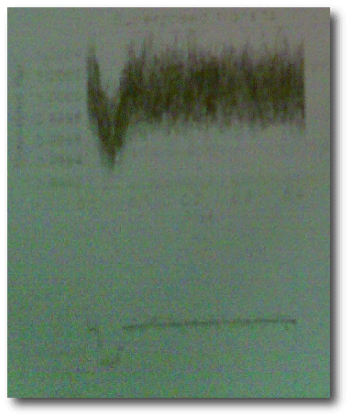
From a cell phone picture transmitted by an oklo.org agent
The photo above is grainy, but what’s truly remarkable is that the depth of the dip is only 0.03%. Earth transiting in front of the Sun as seen from afar blocks roughly 0.01% of the Sun’s light. Look at the signal-to-noise of the bottom composite-average curve.
I can sure empathize with the CoRoT team. Their symposium date was set up long ago. Kepler is launching in a few weeks. The results of the Doppler surveys are suggesting that super-Earths with orbital periods of 50 days or less (with correspondingly high transit probabilities) are present around 30% of solar-type stars. Ground-based photometry is pushing below 0.5 millimagnitudes at 1-minute cadence. The pressure is on. And there’s an absolutely fascinating candidate planet that isn’t quite yet out of the oven, due to a paucity of high-precision radial velocities that would pin down the mass. What do you do?
I agree! You go ahead and announce.
Everything about CoRoT-7b reemphasizes the fact that planets are wont to turn up in every corner of parameter space to which observations are sensitive. In this case, a V=11 K0V star in the direction of the galactic anti-center displays 176 individual 1.5-hour 0.3 mmag photometric dips with a strict 0.854 day periodicity. These measurements suggest a 1.7 Earth-radii planet with a 20-hour year — a world that makes 51 Peg b look like Fargo North Dakota.
The abstract for Daniel Rouan’s talk at the meeting (transcribed from the cell phone photograph) describes the procedures that the CoRoT team has implemented to rule out the various false positives that can plague transit surveys. This gives a sense of the amount of follow-up work that needs to be done in order to secure a planet as small as this one (also, see comments section for this post, for many additional details):
To qualify/falsify the interpretation of the observed transits, we have considered different alternative interpretations: (1) transit of a main sequence star in front of a giant star — rejected by the measured log(g) of the target; (2) a grazing eclipse by a stellar companion — rejected by the radial velocity measurements (3) a weak Background Eclipsing Binary that would be inside the target mask — partially rejected by on/off transit photometric observations performed from the ground at angular distance from the target larger than 2 arcsec, and by high-resolution imaging at distances larger than 0.3 arcsec. (4) a triple system made of the target star (K0V) and a faint star (M5V) eclipsed by a giant planet or a dark stellar companion — rejected by the study of the transit colours which are the same as those of the main target.
Exoplanet.eu is quoting a significantly uncertain mass of 0.035 Jupiter masses (11 Mearth) for the planet, a figure that could have been arrived at via assumptions about the density and/or limits on the radial velocity detection. An 11 Earth-mass planet would induce an eminently detectable K=8 m/s RV signal, so it’s a bit odd that a firmer estimate of the mass isn’t available yet. The CoRoT “galactic anticenter” field is located in Monoceros, at RA~06h 45m, DEC~+0d, meaning that the candidate star is currently visible to HARPS (at air mass <2) all through the first half of the night. Exoplanet.eu also states an age of 1.1 Gyr for the star, so youth, with its attendant stellar activity, could possibly be making it tough to get good velocity precision.
In any case, it’s a remarkable detection, and will be hugely influential as soon as the mass is confirmed. The planet is orbiting at only four stellar radii — with the star filling nearly a thousand square degrees of sky…
